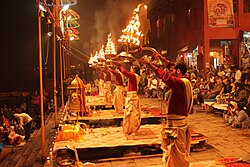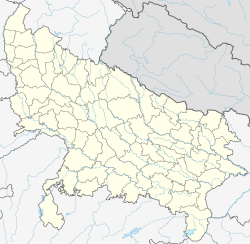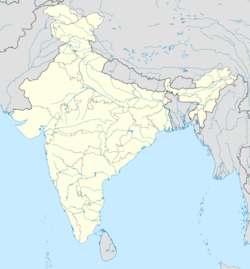Varanasi: Difference between revisions
(Created page with "{{Short description|Metropolis in Uttar Pradesh, India}} {{Distinguish |Varanasi division|Varanasi district|Varanasi Tehsil}} {{Redirect|Banaras}} {{pp|small=yes}} {{Use dmy d...") |
No edit summary |
||
| Line 106: | Line 106: | ||
{{Saivism}} | {{Saivism}} | ||
'''Varanasi''' ({{IPA-hns|ʋaːˈraːɳəsi|-|hi-Varanasi.ogg}}), also known as '''Benares''',<ref>[//upload.wikimedia.org/wikipedia/commons/3/36/British_Indian_Empire_1909_Imperial_Gazetteer_of_India.jpg The name that appears on the 1909 version official map of India]</ref> or '''Banaras''' (''Banāras'' {{IPA-hns|bəˈnaːrəs||hi-Banaras.ogg}}), is a city on the banks of the river [[Ganges]] in [[Uttar Pradesh]], [[India]], {{convert|320|km|mi|-1}} south-east of the state capital, [[Lucknow]], and {{convert|121|km}} east of [[Allahabad]]. A major religious hub in [[India]], it is the [[Holy city|holiest]] of the seven sacred cities (''[[Sapta Puri]]'') in [[Hinduism]] and [[Jainism]], and played an important role in the development of [[Buddhism]] and [[Ravidassia]]. Varanasi lies along [[National Highway 19 (India)|National Highway 2]], and is served by [[Varanasi Junction railway station]] and [[Lal Bahadur Shastri International Airport]]. | '''Varanasi''' ({{IPA-hns|ʋaːˈraːɳəsi|-|hi-Varanasi.ogg}}), also known as '''Benares''',<ref>[//upload.wikimedia.org/wikipedia/commons/3/36/British_Indian_Empire_1909_Imperial_Gazetteer_of_India.jpg The name that appears on the 1909 version official map of India]</ref> or '''Banaras''' (''Banāras'' {{IPA-hns|bəˈnaːrəs||hi-Banaras.ogg}}), is a city on the banks of the river [[Ganges]] in [[Uttar Pradesh]], [[India]], {{convert|320|km|mi|-1}} south-east of the state capital, [[Lucknow]], and {{convert|121|km}} east of [[Allahabad]]. A major religious hub in [[India]], it is the [[Holy city|holiest]] of the seven sacred cities (''[[Sapta Puri]]'') in [[Hinduism]] and [[Jainism]], and played an important role in the development of [[Buddhism]] and [[Ravidassia]]. Varanasi lies along [[National Highway 19 (India)|National Highway 2]], and is served by [[Varanasi Junction railway station]] and [[Lal Bahadur Shastri International Airport]]. | ||
Varanasi grew as an important industrial centre famous for its [[muslin]] and silk fabrics, perfumes, ivory works, and sculpture. [[Buddha]] is believed to have founded Buddhism here around 528 BCE when he gave his first sermon, "[[Dhammacakkappavattana Sutta|The Setting in Motion of the Wheel of Dharma]]", at nearby [[Sarnath]]. The city's religious importance continued to grow in the 8th century, when [[Adi Shankara]] established the [[Shaivism|worship of Shiva]] as an official sect of Varanasi. During the Muslim rule through the Middle Ages, the city continued as an important centre of Hindu devotion, pilgrimage, [[mysticism]] and poetry which further contributed to its reputation as a centre of cultural importance and religious education. [[Tulsidas]] wrote his epic poem on [[Rama]]'s life called ''[[Ram Charit Manas]]'' in Varanasi. Several other major figures of the [[Bhakti movement]] were born in Varanasi, including [[Kabir]] and [[Ravidas]].<ref>{{Cite web|url=https://www.sundayguardianlive.com/culture/spirit-kabir-took-ancient-ghats-benares|title=When the spirit of Kabir took over the ancient ghats of Benares|date=30 November 2019|website=The Sunday Guardian Live|access-date=29 December 2019}}</ref> [[Guru Nanak]] visited Varanasi for [[Maha Shivaratri]] in 1507, a trip that played a large role in the founding of [[Sikhism]]. | |||
== References == | |||
Revision as of 23:28, 27 May 2021
Varanasi
| |
|---|---|
Left to Right, Top to Bottom:
Ahilya Ghat, Chet Singh Ghat, Munshi Ghat, Ganga Aarti, Dashashwamedh Ghat | |
| Nickname: The spiritual capital of India | |
| Coordinates: 25°19′08″N 83°00′46″E / 25.31889°N 83.01278°ECoordinates: 25°19′08″N 83°00′46″E / 25.31889°N 83.01278°E | |
| Country | |
| State | Uttar Pradesh |
| Division | Varanasi |
| District | Varanasi |
| Government | |
| • Type | Municipal Corporation |
| • Body | Varanasi Municipal Corporation |
| • Mayor | Mridula Jaiswal (BJP) |
| • Divisional Commissioner | Deepak Agarwal, IAS |
| • District Magistrate | Kaushal Raj Sharma, IAS |
| • Inspector General, Varanasi Range | Vijay Singh Meena, IPS |
| • Senior Superintendent of Police | Prabhakar Chaudhary, IPS |
| Area | |
| • Metropolis | 82 km2 (32 sq mi) |
| • Metro | 163.8 km2 (63.2 sq mi) |
| Elevation | 80.71 m (264.80 ft) |
| Population (2011) | |
| • Metropolis | 1,212,610[2] |
| • Rank | 31st |
| • Metro | 1,432,280 (32nd) |
| Language | |
| • Official | Hindi[6] |
| • Additional official | Urdu[6] |
| • Regional | Bhojpuri |
| Time zone | UTC+5:30 (IST) |
| PIN | 221 001 to** (** area code) |
| Telephone code | 0542 |
| Vehicle registration | UP 65 |
| GDP | $3.07 billion (2016–17)[7] |
| Per capita income | INR 1,93 616[8] |
| Sex ratio | 0.926 (2011) ♂/♀ |
| Literacy (2011) | 80.31%[9] |
| HDI | 0.645[10] |
| Website | varanasi |
| Part of a series on |
| Hinduism |
|---|
 |
| Part of a series on |
| Vaishnavism |
|---|
 |
|
|
| Part of a series on |
| Shaivism |
|---|
 |
|
|
Varanasi (Hindustani pronunciation: [ʋaːˈraːɳəsi] (![]() listen)), also known as Benares,[11] or Banaras (Banāras [bəˈnaːrəs] (
listen)), also known as Benares,[11] or Banaras (Banāras [bəˈnaːrəs] (![]() listen)), is a city on the banks of the river Ganges in Uttar Pradesh, India, 320 kilometres (200 mi) south-east of the state capital, Lucknow, and 121 kilometres (75 mi) east of Allahabad. A major religious hub in India, it is the holiest of the seven sacred cities (Sapta Puri) in Hinduism and Jainism, and played an important role in the development of Buddhism and Ravidassia. Varanasi lies along National Highway 2, and is served by Varanasi Junction railway station and Lal Bahadur Shastri International Airport.
listen)), is a city on the banks of the river Ganges in Uttar Pradesh, India, 320 kilometres (200 mi) south-east of the state capital, Lucknow, and 121 kilometres (75 mi) east of Allahabad. A major religious hub in India, it is the holiest of the seven sacred cities (Sapta Puri) in Hinduism and Jainism, and played an important role in the development of Buddhism and Ravidassia. Varanasi lies along National Highway 2, and is served by Varanasi Junction railway station and Lal Bahadur Shastri International Airport.
Varanasi grew as an important industrial centre famous for its muslin and silk fabrics, perfumes, ivory works, and sculpture. Buddha is believed to have founded Buddhism here around 528 BCE when he gave his first sermon, "The Setting in Motion of the Wheel of Dharma", at nearby Sarnath. The city's religious importance continued to grow in the 8th century, when Adi Shankara established the worship of Shiva as an official sect of Varanasi. During the Muslim rule through the Middle Ages, the city continued as an important centre of Hindu devotion, pilgrimage, mysticism and poetry which further contributed to its reputation as a centre of cultural importance and religious education. Tulsidas wrote his epic poem on Rama's life called Ram Charit Manas in Varanasi. Several other major figures of the Bhakti movement were born in Varanasi, including Kabir and Ravidas.[12] Guru Nanak visited Varanasi for Maha Shivaratri in 1507, a trip that played a large role in the founding of Sikhism.
References
- ↑ "Varanasi: About the city". Official website of Uttar Pradesh Tourism. Archived from the original on 8 July 2013. Retrieved 23 May 2013.
- ↑ Cite error: Invalid
<ref>tag; no text was provided for refs namedurban - ↑ "Varanasi City".
- ↑ "District Census Handbook Varanasi" (PDF). censusindia.gov.in. Retrieved 23 December 2020.
- ↑ "Urban Agglomerations/Cities having population 1 lakh and above" (PDF). Office of the Registrar General & Census Commissioner, India. Archived (PDF) from the original on 17 October 2013. Retrieved 12 May 2014.
- ↑ 6.0 6.1 "52nd Report of the Commissioner for Linguistic Minorities in India" (PDF). nclm.nic.in. Ministry of Minority Affairs. Archived from the original (PDF) on 25 May 2017. Retrieved 26 December 2018.
- ↑ "Yogi Adityanath is right. Route to UP's $1 trillion GDP goal passes through hinterland". Retrieved 25 September 2019.
- ↑ "Executive Summary" (PDF). Retrieved 29 December 2019.
- ↑ "Slum Free City Plan of Action Varanasi" (PDF).
- ↑ http://ssca.org.in/media/4_2016_HDI_t1hcMZm.pdf
- ↑ The name that appears on the 1909 version official map of India
- ↑ "When the spirit of Kabir took over the ancient ghats of Benares". The Sunday Guardian Live. 30 November 2019. Retrieved 29 December 2019.









